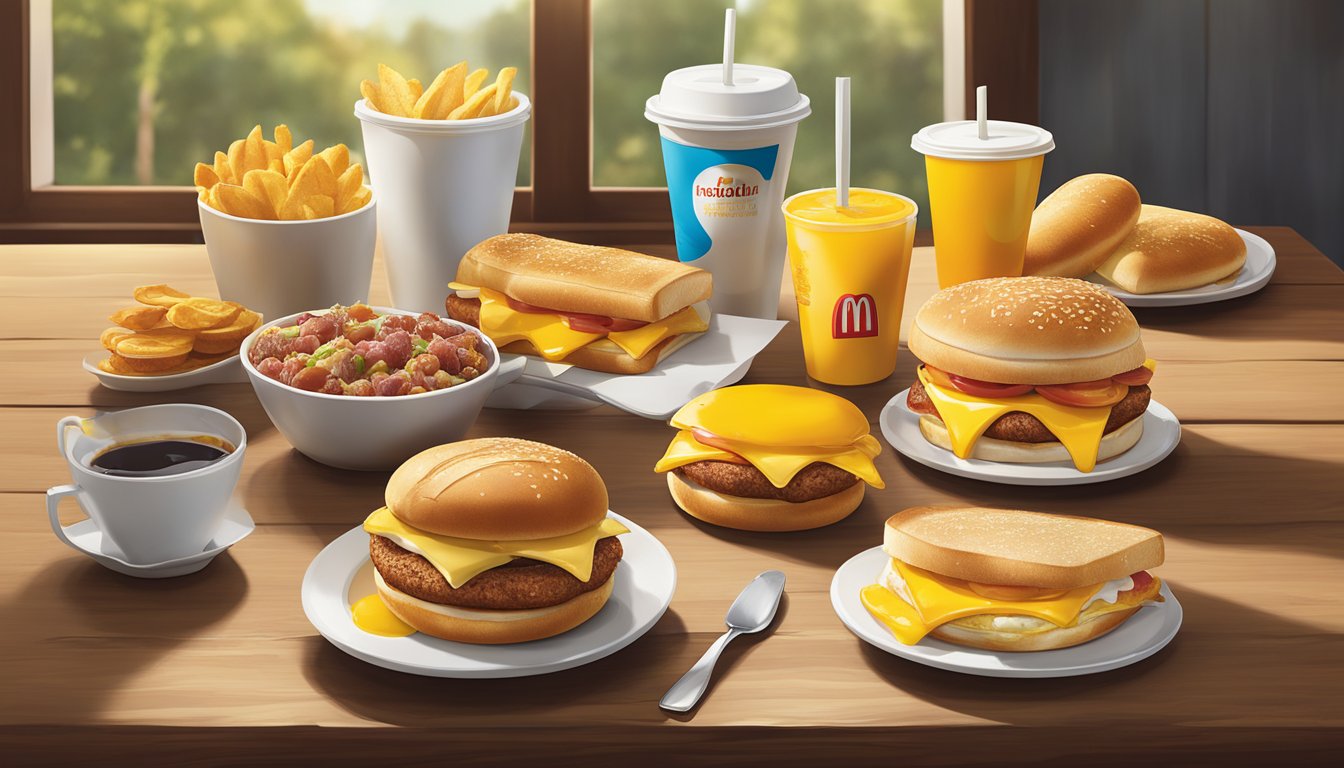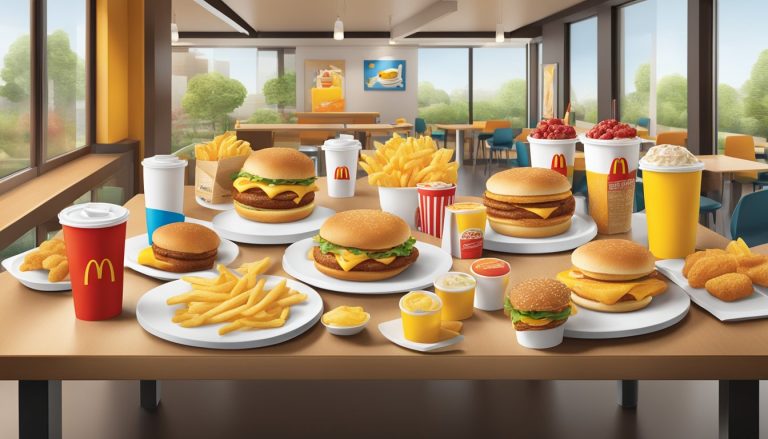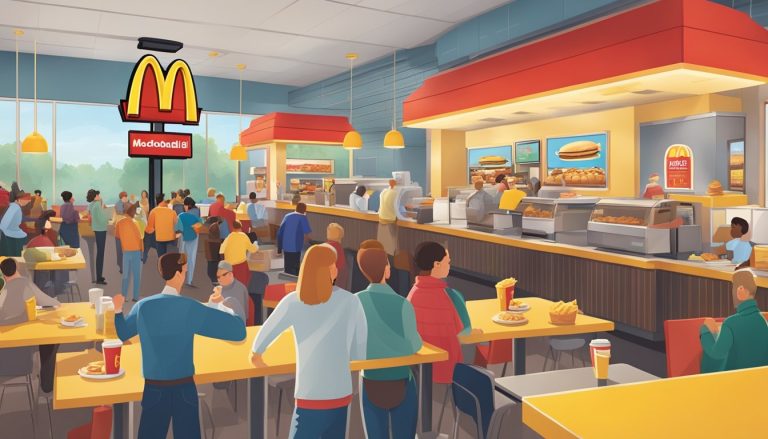McDonald’s breakfast menu has become an iconic part of American fast-food culture since its introduction in the 1970s. Over the decades, the way this morning fare is presented to consumers has evolved significantly, reflecting broader changes in food photography and marketing techniques.
Food stylists and photographers now employ sophisticated methods to make McDonald’s breakfast items appear irresistible in advertisements and promotional materials. These professionals use careful lighting, strategic placement, and subtle enhancements to showcase the textures and colors of Egg McMuffins, hash browns, and coffee. The goal is to create images that evoke the warmth and comfort of a satisfying breakfast while maintaining an appetizing and realistic appearance.
The shift in food photography aesthetics has paralleled changes in consumer expectations and media consumption. Social media platforms have raised the bar for visual appeal, prompting fast-food chains like McDonald’s to adapt their imagery to be more Instagram-worthy. This evolution in food presentation reflects the ongoing interplay between culinary trends, technology, and marketing strategies in the competitive fast-food landscape.
The Evolution of McDonald’s Breakfast
McDonald’s breakfast offerings have undergone significant changes since their introduction, adapting to consumer preferences and market trends. The menu has expanded from a single innovative sandwich to a diverse array of options available throughout the day.
From Egg McMuffin to Big Breakfast
The Egg McMuffin, introduced in 1971, marked the beginning of McDonald’s breakfast era. This simple yet revolutionary sandwich combined an egg, Canadian bacon, and cheese on a toasted English muffin. Its success paved the way for a full breakfast menu launch in 1977.
The menu expanded to include Hotcakes, becoming a popular choice for those seeking a sweeter start to their day. McDonald’s also introduced the Big Breakfast, a hearty plate featuring scrambled eggs, sausage, hash browns, and a biscuit.
These core items quickly became breakfast staples, appealing to a wide range of customer preferences and establishing McDonald’s as a major player in the morning food market.
Expanding the Breakfast Menu
Throughout the 1980s and 1990s, McDonald’s continued to innovate its breakfast offerings. The chain introduced new items to cater to changing tastes and dietary trends.
Healthier options like fruit and yogurt parfaits joined the menu, providing alternatives to traditional breakfast fare. The Breakfast Burrito made its debut, adding a touch of Tex-Mex flavor to the morning lineup.
Regional variations also emerged, with menu items tailored to local tastes in different countries. For example, porridge became available in the UK, while congee was offered in some Asian markets.
Advent of the All-Day Breakfast
In 2015, McDonald’s made a groundbreaking move by introducing All-Day Breakfast. This decision allowed customers to enjoy breakfast items beyond traditional morning hours, meeting the demands of those craving breakfast foods later in the day.
The All-Day Breakfast menu initially included a selection of popular items like the Egg McMuffin, Hotcakes, and hash browns. Its success led to an expanded offering, with more breakfast items becoming available throughout the day.
This change not only boosted sales but also increased customer satisfaction. It provided greater flexibility for customers with non-traditional schedules and catered to the growing trend of breakfast foods being enjoyed at any time.
Analysis of Breakfast Menu Items
McDonald’s breakfast menu offers a diverse range of options to cater to different tastes and dietary preferences. The menu balances classic favorites with healthier alternatives, providing choices for various customer needs.
Coffee and Its Companions
McDonald’s coffee has become a morning staple for many customers. The chain offers a variety of coffee options, from regular brewed coffee to espresso-based drinks like lattes and cappuccinos.
Eggs feature prominently as a companion to coffee. The Egg McMuffin, a classic breakfast sandwich, pairs a toasted English muffin with a perfectly round egg, Canadian bacon, and cheese.
For those seeking a heartier option, the Big Breakfast combines scrambled eggs, sausage, hash browns, and a toasted biscuit. This meal provides a substantial start to the day, appealing to customers with larger appetites.
Healthy Choices: Yogurt and Fruit Options
McDonald’s has expanded its menu to include healthier breakfast alternatives. The Fruit and Maple Oatmeal offers a warm, nutritious option made with whole grain oats and topped with fresh apple slices and cranberry-raisin blend.
Low-fat yogurt parfaits provide a lighter choice. These parfaits layer creamy yogurt with crunchy granola and fresh berries, offering a balance of protein, carbohydrates, and essential nutrients.
For those watching their calorie intake, the Egg White Delight McMuffin presents a leaner version of the classic sandwich. It features egg whites, white cheddar cheese, and Canadian bacon on a toasted English muffin.
The Appeal of Hotcakes and Hash Browns
Hotcakes remain a beloved item on McDonald’s breakfast menu. Served with butter and syrup, these fluffy pancakes offer a sweet indulgence for those with a morning sweet tooth.
Hash browns complement many breakfast items as a popular side. These crispy potato patties provide a satisfying crunch and savory flavor, often paired with sandwiches or eaten on their own.
The Sausage McGriddles sandwich combines sweet and savory flavors. It features a sausage patty between two warm griddle cakes infused with sweet maple flavor, creating a unique taste experience.
The Breakfast Wars in the Fast-Food Industry
The fast-food breakfast market has become a fiercely competitive arena, with major chains vying for customer loyalty and market share. McDonald’s emerged as a dominant force, setting trends and driving innovation in breakfast offerings.
McDonald’s vs. Burger King: A Competition Analysis
McDonald’s and Burger King have long been rivals in the breakfast space. McDonald’s gained an early advantage with its iconic Egg McMuffin, introduced in 1972. This move helped establish the chain as a breakfast destination.
Burger King responded with its own breakfast menu, featuring items like the Croissan’wich. The two chains have since engaged in ongoing menu innovation and promotional tactics to attract morning customers.
McDonald’s has maintained a significant lead, capturing 35.4% of fast-food breakfast visits in 2023. Burger King has struggled to match this market share, despite efforts to expand its breakfast options.
How McDonald’s Sets the Trend for Breakfast
McDonald’s has consistently led breakfast trends in the fast-food industry. The chain’s all-day breakfast launch in 2015 forced competitors to reevaluate their strategies.
McDonald’s breakfast success stems from:
- Menu innovation (e.g., McGriddles, breakfast burritos)
- Consistent quality across locations
- Efficient service during peak morning hours
- Strategic pricing to maintain value perception
The company’s breakfast sales reached $10 billion in 2012, demonstrating its dominance. This success has prompted other chains to invest heavily in their breakfast offerings, fueling the ongoing breakfast wars.
McDonald’s continues to adapt to changing customer preferences, introducing healthier options and premium coffee drinks to maintain its breakfast market leadership.
Marketing Strategies for Breakfast Items
McDonald’s employs innovative marketing tactics to promote its breakfast offerings. These strategies focus on digital platforms and personalized customer experiences to drive engagement and sales.
Leveraging Social Media for Breakfast Campaigns
McDonald’s utilizes social media platforms to showcase its breakfast menu. Instagram and Facebook feature appetizing photos of Egg McMuffins and hash browns. Twitter hosts contests and promotions, encouraging customers to share their breakfast experiences.
The company partners with influencers to create buzz around new items. Food bloggers and lifestyle influencers post about trying the latest breakfast offerings. This generates authentic content and reaches diverse audiences.
McDonald’s also uses targeted ads on social platforms. These ads highlight breakfast deals and new menu items to users during morning hours. Location-based targeting ensures promotions reach customers near McDonald’s restaurants.
Targeted Campaigns and Customer Engagement
McDonald’s tailors its breakfast marketing to specific customer segments. The company uses data analytics to understand consumer preferences and behaviors. This informs personalized offers and promotions.
Email campaigns deliver breakfast coupons and notify customers of limited-time offers. The McDonald’s mobile app provides exclusive breakfast deals and allows for easy ordering and customization.
In-store promotions encourage breakfast purchases. Combo meals and value offerings appeal to budget-conscious customers. Seasonal items, like Pumpkin Spice Lattes, create excitement and drive traffic during specific times of the year.
McDonald’s also adapts its breakfast marketing to local tastes. Regional menu items and promotions cater to diverse cultural preferences, enhancing customer loyalty and satisfaction.
Supply Chain and Its Impact on Breakfast Offerings
McDonald’s breakfast menu relies heavily on a complex supply chain to deliver fresh ingredients daily. The sourcing and distribution of key items like eggs and coffee present unique challenges and opportunities for the fast food giant.
Challenges in the Food Supply Chain
McDonald’s faces several hurdles in maintaining its breakfast supply chain. Egg shortages can disrupt menu offerings. The company requires millions of eggs daily for items like McMuffins.
Weather events and avian flu outbreaks have caused supply issues in recent years. To mitigate risks, McDonald’s works with multiple egg suppliers across different regions.
Coffee bean sourcing also presents challenges. Price fluctuations and crop failures can impact costs. McDonald’s partners with suppliers to ensure consistent quality and sustainable farming practices.
Sourcing Ingredients for a Diverse Breakfast Menu
McDonald’s sources ingredients from a vast network of suppliers to support its breakfast menu. The company prioritizes food safety and quality control throughout the supply chain.
For eggs, McDonald’s uses a mix of conventional and cage-free sources. The transition to cage-free eggs is ongoing in many markets. Coffee beans are sourced from regions like Latin America and Indonesia.
Some markets incorporate local breakfast preferences. In Hawaii, Spam is offered as a breakfast protein option. This requires coordinating with regional suppliers.
Baked goods like muffins and biscuits are often produced by dedicated bakeries. These facilities must meet strict quality and food safety standards set by McDonald’s.
Customer Demand and Its Influence on Menu Development

McDonald’s has long been attuned to shifting consumer preferences. The introduction of All-Day Breakfast in 2015 exemplified their responsiveness to customer demand.
Changing work schedules and lifestyle habits blurred traditional mealtimes, leading to increased desire for flexible dining options. McDonald’s capitalized on this trend by offering breakfast items around the clock.
The company also recognized growing interest in healthier fare. They expanded their menu to include more nutritious options like salads, fruit smoothies, and grilled chicken.
Customer feedback played a crucial role in shaping the Happy Meal. McDonald’s added apple slices and reduced the portion size of fries in response to parents’ concerns about childhood nutrition.
Menu innovation continues to be driven by consumer preferences:
- Plant-based options
- Customizable burgers
- Premium coffee drinks
These additions reflect McDonald’s commitment to meeting evolving tastes while maintaining their core offerings.
Digital ordering platforms have provided valuable data on customer preferences, allowing McDonald’s to refine their menu and introduce new items more effectively.
By staying responsive to customer demand, McDonald’s has managed to maintain its position as a leader in the fast-food industry despite changing consumer habits and increased competition.
The Role of Food Photography in Branding Breakfast Items

Food photography plays a crucial role in branding McDonald’s breakfast items. High-quality images capture the appetizing qualities of menu offerings, enticing customers to try new products.
Professional photographers use various techniques to enhance the visual appeal of breakfast foods. They focus on showcasing vibrant colors, textures, and freshness to make items look irresistible.
Lighting is key in breakfast food photography. Many shoots aim to recreate the warm glow of morning sunlight, creating an inviting atmosphere that resonates with early risers.
Marketing strategies heavily rely on these captivating images. They appear on menus, advertisements, and promotional materials, helping to build brand recognition and customer loyalty.
Social media platforms have amplified the impact of food photography. Eye-catching breakfast photos shared on Instagram and Facebook generate engagement and inspire customers to visit McDonald’s.
Food stylists work meticulously to perfect each item’s appearance. They carefully arrange ingredients, adjust garnishes, and ensure every detail looks appetizing on camera.
Consistency in food photography helps maintain McDonald’s brand identity. Images across different markets and campaigns share a unified aesthetic, reinforcing the company’s global presence.
Recent trends in food photography emphasize authenticity. McDonald’s has adapted by showcasing more realistic representations of their breakfast items, building trust with consumers.




